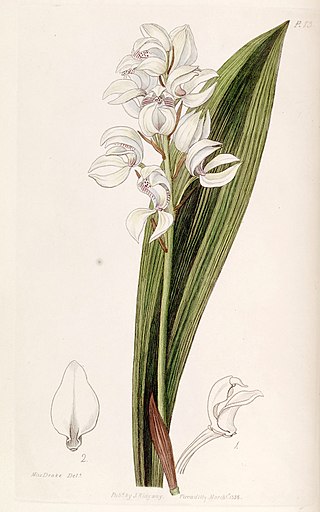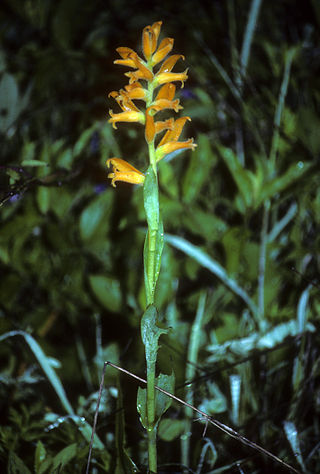Pima Bajo is a Mexican indigenous language of the Piman branch of the Uto-Aztecan language family, spoken by around 1,000 speakers in northern Mexico. The language is called O'ob No'ok by its speakers. The closest related languages are O'odham and the O'othams.

Govenia liliacea is a species of orchid. Its native range extends from Chihuahua south to Panama.

Salix taxifolia, the yewleaf or yew-leaf willow, is a species of willow native to all of southern Mexico, also Pacific Coast regions, north to Sinaloa, and in the south Pacific Coast of Mexico into central Guatemala. Scattered populations are also reported from northern Mexico and from the US states of Texas, New Mexico, and Arizona.

The Pima Bajo people are indigenous people of Mexico who reside in a mountainous region along the line between the states of Chihuahua and Sonora in northern Mexico. They are related to the Pima and Tohono O’odham of Arizona and northern Sonora, speaking a similar but distinct language.

Hymenocallis pimana is a member of the genus Hymenocallis, in the family Amaryllidaceae. Common name in English is Pima spider-lily; in Spanish it is cebollín. It is endemic to a small mountainous region in the Sierra Madre Occidental, straddling the Mexican states of Chihuahua and Sonora. Many of the people of the region are of the indigenous group known as the Mountain Pima or Pima Bajo.
Berberis pimana is a species of the genus Berberis in the family Berberidaceae. It is native to a mountainous region of the Sierra Madre Occidental in the Mexican states of Chihuahua and Sonora.
Pectis pimana is an herbaceous plant in the family Asteraceae. It is endemic to a mountainous area in the Sierra Madre Occidental, in the Mexican State of Chihuahua. Type locale is the village of Nabogame, 18 km northwest of Yepachic and about 10 km east of the state line with Sonora. Most of the inhabitants of Nabogame are of the indigenous ethnic group known as the Mountain Pima or Pima Bajo; the specific epithet "pimana" was chosen in their honor.

Begonia gracilis is a species of flowering plant in the family Begoniaceae. It is a small herb widespread in the mountains of Mexico, from Chihuahua to Chiapas, often growing in protected locations in shaded areas.
Rubus sierrae is a small Mexican species of shrub in the genus Rubus, family Rosaceae. It is known from a single collection from near the village of Nabogame, Chihuahua, Mexico, in the Sierra Madre Occidental approximately 18 km northwest of Yepachic. The specimen was collected in riparian forest dominated by Acer grandidentatum Nutt. and Cupressus lusitanica.

Cochemiea barbata is a small cactus native to Chihuahua, Sonora, and Durango, with the common name greenflower nipple cactus. It is found in mountainous locations in the Sierra Madre Occidental. It has delicate white to pink flowers. The fruits are red and oblong. They are edible but too small to be of much food value to humans.

Passiflora bryonioides, the cupped passionflower, is a plant in the genus Passiflora, family Passifloraceae. It is native to northern Mexico and the south-western United States (Arizona).
Physalis caudella, the southwestern groundcherry or tomatillo chiquito, is a plant in the family Solanaceae, native to Arizona, Sonora and Chihuahua. The purple-green fruits are small but edible.

Yucca grandifloraGentry is a plant in the family Asparagaceae, native to the Sierra Madre Occidental in the Mexican states of Chihuahua and Sonora.
Prunus gentryi is a species of wild cherry in the genus Prunus, family Rosaceae, native to the Mexican states of Chihuahua and Sonora. It grows along streambanks in mountainous regions of the Sierra Madre Occidental. The scientific description was published in 1937.
Laennecia pimana is an herbaceous species from Mexico. The plant is known only from the type locale, i.e., the village of Nabogame, 18 km northwest of Yepachi, Chihuahua, at an elevation of approximately 1800 m in the Sierra Madre Occidental.
Prionosciadium saraviki, common name saraviki, is a plant species in the genus Prionosciadium, in the carrot family, Apiaceae. It is known only from a mountainous region of the Sierra Madre Occidental in the Mexican State of Chihuahua. Type locale is the village of Nabogame, approximately 18 km northwest of Yepachic, Chihuahua, 10 km east of the border with Sonora. The plant grows there mostly along creekbanks and near springs.

Yepáchic, sometimes spelled Yepáchi, is a community in the western part of the Mexican State of Chihuahua, approximately 10 km (6.2 mi) east of the boundary with the State of Sonora. It is located in the Municipio de Temósachic at an altitude of 1,780 meters (5,840 ft) in the Sierra Madre Occidental. Many of the people of the region are members of the indigenous ethnic group called Mountain Pima or the Pima Bajo. They are related to the Pima and Papago of Arizona and northern Sonora, speaking a similar but distinct language.

Jaltomata procumbens, the creeping false holly, is a plant species native to Arizona, USA, Mexico, Central America, Colombia, Ecuador, and Venezuela. It grows as a weed in agricultural fields and other disturbed locations, but in many places the people protect it because of the edible fruits it produces.
Joseph Edward Laferrière is an American botanist with a particular interest in ethnobotany.

Dichromanthus aurantiacus is a terrestrial species of orchid. It is native to much of Mexico, Guatemala, Honduras and El Salvador. It is a common and conspicuous weed in fallow fields in much of the region.









